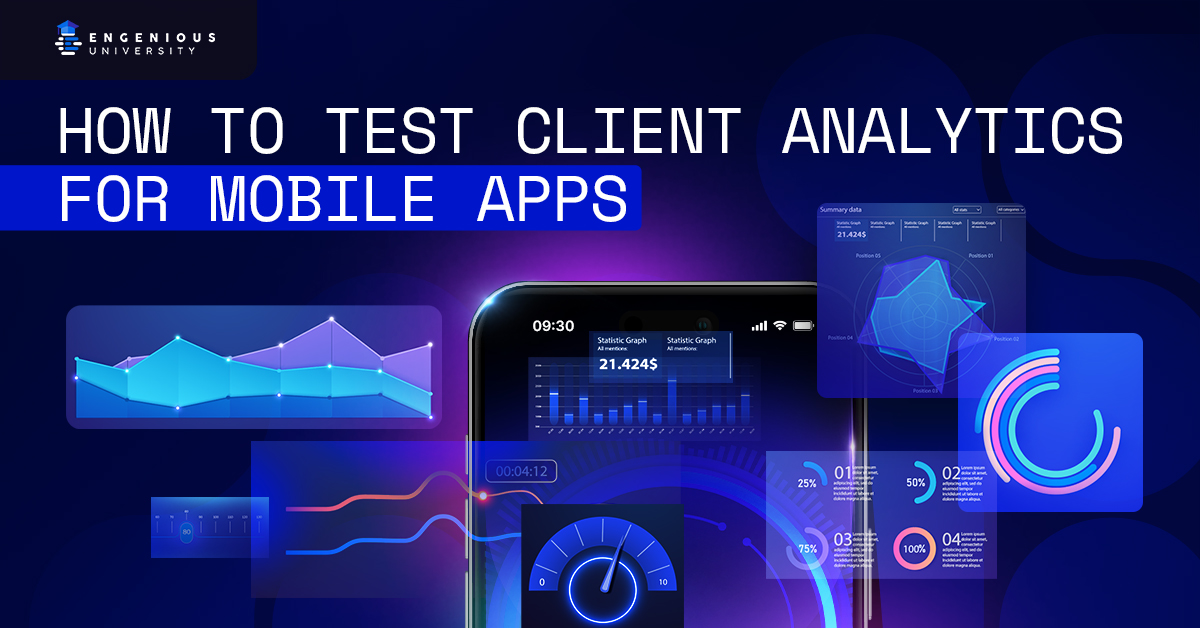Did you know that just one undiscovered bug in a mobile app’s code can cost over $1 million or more? Not to sound too dramatic, but missing the smallest of mistakes when testing analytics for mobile apps can significantly cut into app revenue, lower usability, and anger or lose customers. As such, every automation tester must exercise extreme diligence when inspecting the analytics of any app you are responsible for to prevent million-dollar problems from occurring.
Why are mobile app analytics so important?
Automated penetration testing of analytics for mobile apps is critical for every client, but is essential for any corporate client worth millions of dollars. In all likelihood, your clients will want to know how their app is being used, by whom, and for what reasons. Such notable analytics can include target audience demographics, what parts of the app are being accessed, what actions are being taken, and how long users are using the app.

Monitoring this information effectively can have critical effects on continued app maintenance and development. Test automation engineers need to know what features to add or cut, what tools work and which do not, and essentially if the app is effective for its intended purpose for its target audience. Additionally, your clients will want to know if business goals are being met by using the app. Business goals can vary across different industries as well as the types of apps they employ, but some goal types include higher revenue, increased awareness among a target audience, better access to products and services, and other such KPIs.
Examples of top mobile app analytics testing programs
While not every mobile app analytics tool is created the same, they all provide insight into how a mobile app is performing its essential functions and where opportunities for improvement might be. Given user feedback and experience from our own test automation engineers, here is a list of our top 10 tools you may want to consider for your analytics testing needs:
Each tool has its merits and challenges, so be sure to check out our reviews on each to make the best decision for your particular needs.
What mobile app analytics data is critical?
No matter which analytics tool you end up choosing or what the functionality of your client’s app is, here is a list of data points that you should be concerned with when examining critical data points:
- Active Users: View the various activities of people using the app currently or within a recent time period to see how they use the app daily, weekly, monthly, or beyond.
- Adoption & acquisition: Part of an app’s adoption includes which platform users are downloading the app on. Acquisition details which of your marketing channels have led users to download your app for the first time (website, social media, paid ad, etc.).
- Audience retention: Check out the type of audience the app is attracting based on characteristics such as demographics (gender, age, etc.), location, and device type/platform.
- Conversions: See what events and actions have led to customer conversions over a given time period.
- Engagement: User engagement shows how people are interacting with the app to reveal popular actions, tools, information access, and more.
- Filters: Setting data filters can be very helpful in sifting through data more quickly to identify specific information you want to examine. For mobile app analytics, useful filters include the platform (iOS or Android), date range, defined audiences with similar traits, and user properties (age, gender, device type, etc.)
- Revenue: Understanding who and what are providing the most revenue during specific time periods is crucial to a client’s birdseye view of their financial health.

You also want to keep track of app events and user properties that render important milestones such as increased revenue or engagement. Events are occurrences of significance that are worth measuring according to parameters set to measure said events (i.e. date range, revenue threshold, impressions made, etc.). User properties are attributes that help to identify specific desirable behaviors among users.
Events and user properties are often recorded automatically by mobile app analytic programs, including these subcategories:
- Predefined events: These events are generally used by most mobile app analytics tools and offer pre-determined parameters such as basic actions and the input of information. Automatically collected events are more commonplace interactions with the app and typically do not require additional coding or parameters to be recorded.
- Custom events & parameters: These events do not come standard with analytics tools and are created by engineers to measure events that are more specific to the organization’s app type or industry. For example, a restaurant app may measure how many times a user orders a particular menu item.
- User sessions: The time users spend interacting with an app is just as important as what they do while using the app. The amount of time spent by a user within an app provides insight into a multitude of other analytics; such insights include general interest in the app, which tools are most used, which products and services are most popular, and which aspects need improvement.
Setting testing goals and objectives
Analytics mean very little if you do not have a benchmark to compare them to over time. Every organization must set specific goals from which to judge all analytics flowing in from the analytics tool. Keep in mind that not all goals are necessary for every business or industry, so discussing what goals to set with your client is paramount to the success of any analytics campaign.
The types of goals set can be few in number, or several all at once. Additionally, goals can change annually or vary in time frame. For example, you may want to evaluate how many signups for a subscription service are logged each month, but may also want to evaluate overall app revenue year to year. Some examples of analytics goals that can be set include revenue, social media impressions, products sold, or ebooks downloaded.
IMPORTANT: Be sure to have discussed clear goals with the client based on realistic time frames for the most accurate tracking of goal journeys.
Want to learn more about client analytics testing for mobile apps? Join our Discord community to discuss strategies, get tips from experts, and enhance your skills in mobile analytics testing!
Tracking metrics and goals
After you have set your goals to measure, it’s time to start measuring progress toward achieving those goals. Tracking the events that directly correlate with goal fulfillment within given time frames will inform decisions to change, alter, or improve aspects of the app. Here are some tracking methodologies to be aware of:
- Event tracking: As mentioned above, events are specific actions or results of user interaction with the app that affect metrics and goals set. The ways in which events can be tracked include:
- Who initiated the event?
- When was the event initiated?
- What caused the event to initiate?
- How many times has this event occurred in a given time frame?
- Conversion events: Some events can be set to signal conversion events, which are the most important metrics to watch. Conversion events are typically actions taken by users that directly help an organization achieve its set goals. For example, if an analytics goal is to get customers to buy a new product, a conversion event for this goal would be when a user makes a purchase.
- Automatic: Automatic conversion events are often recorded by analytics tools without needing consent. Such events include when a user first launches the app, makes a purchase through the app, or makes an ecommerce purchase.
- Custom: Custom conversion events are not automated and are created for more specific metrics that are business or industry dependent. For example, a restaurant may want to know how many people get placed on the waitlist on the weekend versus weekdays.
- Audience: These users are the ones you want to track as they are most likely to interact with your app regularly and help you to reach your analytics goals. Audiences also share similar events and user properties. A useful way to divide your audiences is by those users who enact conversion events and those who have yet to do so or seldom do.
- Cohorts: These users are grouped by when they started using your app, typically starting within the same week or month. Tracking cohorts of users allows for viewing customer retention efforts over time.
- Funnel: Tracking users’ journeys through the marketing funnel reveals how many steps they took to finally enact a conversion event and which touchpoints influenced their decision along the way. This information is helpful for finding out what methods are most effective at getting users to convert.
Establishing testing strategies for client analytics
Up until this point, we have discussed how to ensure analytics are set up properly from the beginning to give clients the information they desire about their business efforts. However, what if the mobile app analytics tool is not performing as it should? Data not being tracked and read as intended is one of those million-dollar problems that we discussed earlier. So, how do we ensure the tools are behaving as they should and your clients stay happy?
Here are some of the testing strategies that test automation experts should be employing in their audits:
- Functional testing: Testing basic app analytics functionality ensures that the app correctly tracks and records events. This kind of testing involves verifying the implementation of event tracking, testing the accuracy of data capture, and validating the configuration of custom events and parameters.
- Performance testing: Analytics features need to be assessed regarding their effect on app speed and responsiveness. This testing task includes monitoring the efficiency of data transmission and ensuring that the analytics functionality does not degrade user experience.
- Security testing: Clients will definitely want to confirm that the analytics data is transmitted securely and stored safely to protect their users. Security testing includes checking for data encryption, secure data transmission, and compliance with data privacy laws and regulations.
- Automation in analytics testing: Automating analytics testing can significantly enhance efficiency and accuracy. To enact automation, testers need to select appropriate tools and implement scripts that continuously track and verify analytics data. Automated testing ensures consistent monitoring and helps to quickly identify and rectify issues.
- Best practices testing: To ensure effective analytics testing, it’s crucial to check all analytics features comprehensively. Testers should regularly update test cases to include new analytics functionalities and maintain close collaboration between the testing, development, and analytics teams.
Connect with our Discord community to get real-time support and advice on testing client analytics for mobile apps.
